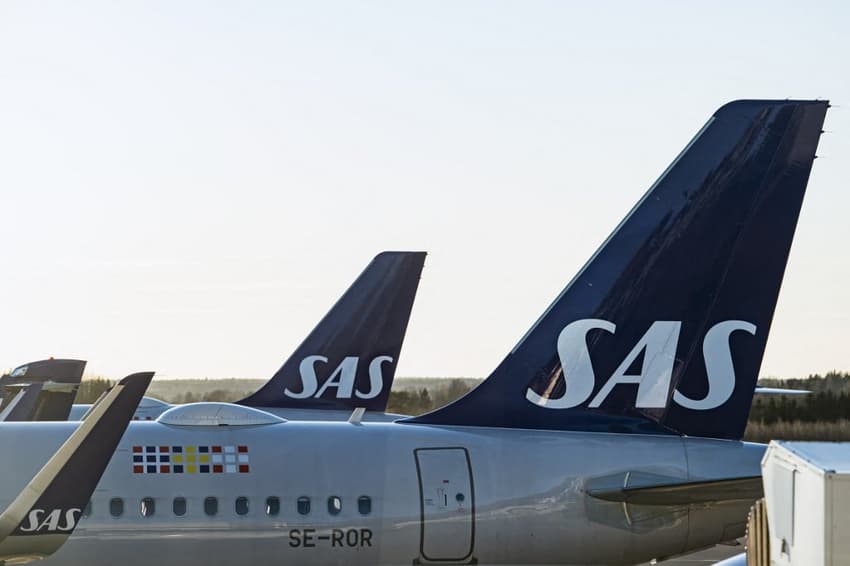Pilots' strike contributes to heavy losses for SAS

Ailing Scandinavian carrier SAS, which filed for bankruptcy protection in the United States in July, widened its losses in the third quarter after a pilot strike, the company said Friday.
The airline posted a net loss of 1.84 billion kronor ($170 million) for the May-July period, compared to a loss of 1.33 billion kronor a year earlier.
Earnings were "severely affected" by the 15-day pilot strike between July 4-19, which led to the cancellation of some 4,000 flights affecting more than 380,000 passengers, the company said in a statement.
However, "overall underlying demand for travel was healthy during the summer quarter" and SAS registered an increasing number of passengers as Covid restrictions were lifted across the globe.
Revenue more than doubled during the quarter, to 8.58 billion kronor from 3.98 billion kronor a year earlier.
The company said it was "cautious" in its outlook for the coming quarter "due to the prevailing uncertainties around the world".
"Traffic to and from Asia remains affected by Covid-19 restrictions as well as by the geopolitical situation", it said.
READ ALSO: Airline Norwegian gets post-Covid boost to profits and passenger numbers
SAS management announced a savings plan in February aimed at ensuring the survival of the company, including cost-cutting of 7.5 billion kronor and dubbed "SAS Forward".
The pilot strike, which cost the carrier between $9 million and $12 million a day, was a protest against salary cuts demanded by management as part of the restructuring plan.
SAS Forward was supplemented in June by a plan to increase capital by nearly one billion euros ($1.04 billion).
Earlier this month, SAS said it had secured a $700 million loan, entering into a debtor-in-possession (DIP) financing credit agreement with funds managed by Apollo Global Management.
Denmark and Sweden are SAS' biggest shareholders with 21.8-percent stakes each.
SAS employs around 7,000 people, mainly in Denmark, Norway and Sweden. It has suffered a string of losses since the start of the coronavirus pandemic in early 2020.
Comments
See Also
The airline posted a net loss of 1.84 billion kronor ($170 million) for the May-July period, compared to a loss of 1.33 billion kronor a year earlier.
Earnings were "severely affected" by the 15-day pilot strike between July 4-19, which led to the cancellation of some 4,000 flights affecting more than 380,000 passengers, the company said in a statement.
However, "overall underlying demand for travel was healthy during the summer quarter" and SAS registered an increasing number of passengers as Covid restrictions were lifted across the globe.
Revenue more than doubled during the quarter, to 8.58 billion kronor from 3.98 billion kronor a year earlier.
The company said it was "cautious" in its outlook for the coming quarter "due to the prevailing uncertainties around the world".
"Traffic to and from Asia remains affected by Covid-19 restrictions as well as by the geopolitical situation", it said.
READ ALSO: Airline Norwegian gets post-Covid boost to profits and passenger numbers
SAS management announced a savings plan in February aimed at ensuring the survival of the company, including cost-cutting of 7.5 billion kronor and dubbed "SAS Forward".
The pilot strike, which cost the carrier between $9 million and $12 million a day, was a protest against salary cuts demanded by management as part of the restructuring plan.
SAS Forward was supplemented in June by a plan to increase capital by nearly one billion euros ($1.04 billion).
Earlier this month, SAS said it had secured a $700 million loan, entering into a debtor-in-possession (DIP) financing credit agreement with funds managed by Apollo Global Management.
Denmark and Sweden are SAS' biggest shareholders with 21.8-percent stakes each.
SAS employs around 7,000 people, mainly in Denmark, Norway and Sweden. It has suffered a string of losses since the start of the coronavirus pandemic in early 2020.
Join the conversation in our comments section below. Share your own views and experience and if you have a question or suggestion for our journalists then email us at [email protected].
Please keep comments civil, constructive and on topic – and make sure to read our terms of use before getting involved.
Please log in here to leave a comment.